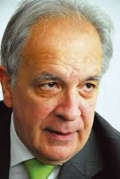2018 International Symposium on Industrial Electronics
1-3 November 2018, Banja Luka, Bosnia and Herzegovina
The Symposium is co-sponsored by IEEE Industry Applications Society, IEEE Power Electronics Society and IEEE Industrial Electronics Society.
Keynote Speakers
NBTI and Radiation Related Degradation and Lifetime Estimation in Power VDMOSFETs

Academician Prof. Dr. Ninoslav Stojadinović
Faculty of Electronic Engineering
University of Nis, Niš, Serbia
Serbian Academy of Sciences and Arts
Belgrade, Serbia
Ninoslav D. Stojadinović (M’86-SM’98-F’03) received B.S. (1974), M.S. (1977) and Ph.D. (1980) degrees, all in electrical engineering, at the Faculty of Electronic Engineering, University of Niš, Serbia, where he was professor at the Department of Microelectronics, Faculty Dean (1989-1994) and Department Head (1985-2005). He is member of Serbian Academy of Sciences and Arts (2003), and Academy of Engineering Sciences of Serbia (1000). His research interest includes semiconductor device physics and modeling and device reliability and failure physics. He has authored or coauthored over 300 papers in the international journals and conference proceedings, and supervised 15 Ph.D theses. He is IEEE ED/SSC Serbia&Montenegro Chapter Chair, IEEE EDS Distinguished Lecturer (since 1997), Chairman of IEEE International Conference on Microelectronics – MIEL (since 2002), and Editor-in-Chief of Facta Universitatis: Electronics and Energetics (since 2013). He was Editor-in-Chief of Microelectronics Journal (1993-1996), IEEE EDS Newsletter (2002-2013), and Microelectronics Reliability (1996-2017).
Threshold voltage shifts associated with NBT (Negative Bias Temperature) instability in power VDMOSFETs under the static and pulsed stress conditions are analyzed in terms of the effects on device lifetime. For that purpose, the method suitable for performing fast NBT instability measurements on power VDMOSFETs is proposed, and its practical implementation using simple boosting circuit for obtaining required gate stress voltage, and sweep I-V measurements for the threshold voltage shift determination will be presented. Experimental results will be discussed in terms of time necessary to perform interim measurements during NBT stress tests, and it will be shown that the measurements could be done fast enough to intercept dynamic recovery effect in these devices.
It should be emphasized that the pulsed bias stressing is found to cause less significant threshold voltage shifts in comparison with those caused by the static stressing.. Accordingly, pulsed gate bias conditions provide much longer device lifetime than the static ones, which is shown by individual use of the 1/VG and 1/T models for extrapolation to normal operation voltage and temperature, as well as by combined use of both models for a double extrapolation successively along both voltage and temperature axes. A double extrapolation approach is shown to allow for construction of the surface area representing the lifetime values corresponding to a full range of device operating voltages and temperatures.
The results of consecutive irradiation and NBT stress experiments performed on power VDMOSFETs will be also presented. It is shown that irradiation of previously NBT stressed devices leads to further increase of threshold voltage shift, while NBT stress effects in previously irradiated devices may depend on gate bias applied during irradiation and on the total dose received. In the case of low-dose irradiation or irradiation without gate bias, the subsequent NBT stress seems to lead to further device degradation, whereas in the case of devices previously irradiated to high doses or with gate bias applied during irradiation, NBT stress seems to have positive role as it practically anneals a part of radiation-induced degradation.
Modular Multilevel Converter Based Conversion for MVDC Applications

Prof. Dr. Drazen Dujic
Power Electronics Laboratory - PEL
Swiss Federal Institute of Technology – EPFL
Lausanne, Switzerland
Drazen Dujic is an Assistant Professor and Head of the Power
Electronics Laboratory at EPFL. He received the Dipl.Ing. and MSc degrees from the University of Novi Sad, Novi Sad, Serbia in 2002
and 2005, respectively, and the PhD degree from Liverpool John Moores University, Liverpool, UK in 2008.
From 2003 to 2006, he was a Research Assistant with the Faculty of Technical Sciences at University of Novi Sad. From 2006 to 2009, he
was a Research Associate with Liverpool John Moores University. After that he moved to industry and joined ABB Switzerland Ltd, where from 2009 to
2013, he was Scientist and then Principal Scientist with ABB Corporate Research Center in Baden-Dättwil, and from 2013 to 2014 he was R&D Platform Manager with ABB Medium Voltage Drives in Turgi. He is with EPFL since 2014. His research interests include the areas of design and control of advanced high power electronic systems and high-performance drives, predominantly for the medium voltage applications related to electrical energy generation, conversion and storage. He has authored or co-authored more than 90 scientific publications and has filed eleven patents.
In 2014, he received The Isao Takahashi Power Electronics Award for Outstanding Achievement in Power Electronics, presented at International Power Electronics Conference, IPEC-Hiroshima 2014, Japan. He is Senior Member of IEEE, EPE Member, and serves as Associate Editor for IEEE Transactions on Power Electronics, IEEE Transactions on Industrial Electronics and IET Electric Power Applications.
Medium Voltage Direct Current (MVDC) power distribution networks are currently being considered for various applications, from large wind and solar power collection and distribution grids to marine on-board electrical systems. Generally, one may consider DC voltage levels from 1.5kV to 50kV to be representative of MVDC voltage range, with power ranging from few MWs to several tens of MWs. Research activities in these areas reveal various technological gaps, predominantly the lack of suitable conversion and protection equipment. In contrast to Solid State Transformers (SSTs), characterized with highly modular converter structures comprising multiple galvanically isolated sub-converter stages, there are other possibilities to realize high-power medium voltage isolated converters employing a single transformer for isolation. The keynote talk will provide an overview of various topologies proposed in the literatures, as well as novel topologies proposed by author’s research laboratory, which will be compared regarding their performances and suitability for various MVDC applications. The Modular Multilevel Converter (MMC), with its excellent voltage scalability through series-connection of cells, offers interesting possibilities for realization of various conversion structures needed in MV applications. From basic characteristics of MMC topology, and its operating principles, various high power MMC-based DC-AC and DC-DC galvanically isolated converters for MVDC applications will be presented and elaborated.















